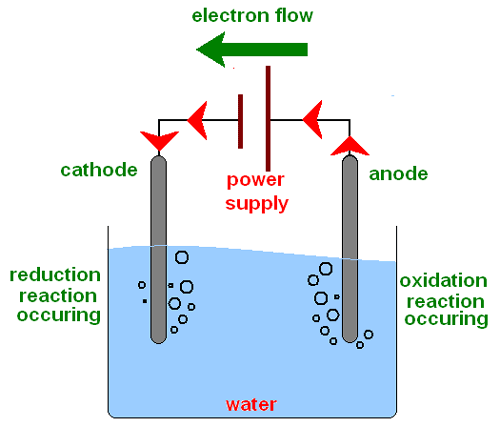Hydrogen Electrolysis
For A Hydrogen Generator
Through a process called hydrogen electrolysis we can make hydrogen gas by
splitting water into oxygen and hydrogen gas. Nearly all the hydrogen on earth is found in water.
Every molecule of water has one oxygen atom and two hydrogen atoms.
Converting Water Into Hydrogen

Converting water into hydrogen is done through an electrical current by running electricity through water (H2O)
to break water molecules into hydrogen and oxygen atoms. With a HHO system
the electricity to operate the electrolyzer is typically supplied by the engines alternator or your vehicles battery.
There are two electrodes one is the cathode, which is the negative electrode, where it creates a negative charge.
This means that there is an electrical pressure to drive electrons into the water at this end. The anode, which is
the positive electrode, creates a positive charge, so that electrode wants to soak up electrons.
This process follows the law of attraction, "opposites attract".
At some stage in this process these molecules split open into a gaseous state. A hydrogen generator
produces this HHO gas, this system is called hydrogen on demand.
The HHO gas is introduced into the intake manifold of your vehicle's engine. In the combustion chamber
it increases the flame speed during the combustion process.
There is a false impression that hydrogen injection systems are burning HHO gas along with your gasoline or diesel fuel,
therefore increasing your miles per gallon. Hydrogen on demand (or HOD) produces HHO gas which is a supplement to your fuel,
it helps burn your gasoline or diesel more efficiently....(read more)
Hydrogen Electrolysis Efficiency
The efficiency of a hydrogen generator is the most important thing.
How efficiently does it create the energy?
If your HHO generator is not efficient, it will cause a host of problems.
Heat is the biggest problem, inefficient HHO generators will climb in heat. When this happens your HHO cell will start to producing steam and
will draw too many amps for your vehicle's battery. An inefficient hydrogen generator also produces a lower grade of HHO gas.
Heat is a symptom of over-worked plates producing hydrogen for more than they were designed to do.
Like installing a Volkswagen engine on a motorhome, it will run for awhile but it will only go about 5 miles per hour, and the engine will
burn up quickly.
This is where we start seeing ridiculous claims from some companies (or individuals) in this industry.
Claiming 10 LPM at 30 amps! I am here to tell you, after doing this since the beginning of 2008,
they are either making steam, not measuring it correctly or not telling
the truth.
LPM is not where it's at - it is EFFICIENCY! To read more on this please see
12 Things You Should Know About
Hydrogen Conversion Kits
With commercial hydrogen fuel cell cars the operation of hydrogen electrolysis is some what opposite of an electrolyzer.
In a fuel cell, hydrogen and oxygen are supplied to the anode and the cathode, and they combine
to form water while creating an electrical current that can be put to use.
In an electrolyzer, an electrical current is applied among the anode and the cathode, which causes the water in the
electrolyte to break down, freeing oxygen gas at the anode and hydrogen gas at the cathode.
You can also read commercial hydrogen cars
concerning the hydrogen economy.
To read about the history of hydrogen and combustion engines please see our Stan Meyer and hydrogen history page.
If you have a question about hydrogen electrolysis or any other question about hydrogen on demand, please click below.
Return From Hydrogen Electrolysis to Hydrogen Generators
Return From Hydrogen Electrolysis to Hydrogen Generators
|





